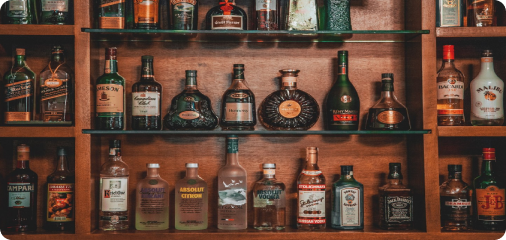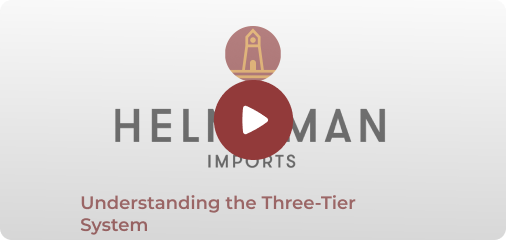When we work with new craft spirits founders, one of the first questions they have is concerning the three-tier distribution system in the United States. It can seem complex (and it is!) but at Helmsman, we’ve navigated this system across multiple brands imported from countries across the globe. Read on to learn about its origins, various legalities, and how it differs across each state.
Prohibition and the Three-Tier System for liquor
The United States outlawed alcohol from 1920-1933 in an attempt to eradicate consumption. During that time period, nefarious elements (remember Al Capone or Nucky Thompson?) began to control the alcohol trade and developed their own vertically integrated system in order to quench the thirst of the American drinker, supported by violence and illegal activity.
After the United States decided to repeal Prohibition in what was called the Volstead Act, the States quickly got to work putting in place a system that, broadly speaking (although there are exceptions!) falls into the following maxim:
-
The owner of a brand can’t own a distributor or a retailer
-
The owner of a distributor can’t own a brand or a retailer
-
The owner of a retailer can’t own a brand or a distributor.
This is what is known as “tied house rules”. It also means you can’t buy off a retailer (which is a common and totally legitimate practice in many or most parts of the world!). It also means you are protected from the big boys swooping in buying up your volume.
One unique thing about the United States is that, similar to the European Union, each State is sovereign and they share certain limited legal powers with the federal government. Traditionally, alcohol falls under public health, which in the Anglo-American tradition is what is known as a police power – a power that is always linked to the State.
This essentially means that each State is like a different country. It also means that for your brand to enter into the United States, it has to cross through a significant number of checkpoints to reach the customer legally.
How do I make sure I stay within the laws when entering the US market?
Where to start…. Well, there’s a lot. And trust me, it’ll give you a headache
-
Register your importer with the state. This is an expensive and lengthy process.
-
Register your label with the state.
-
File reports to the state regulator to make sure you’re paying your taxes.
-
File price posting.
You can do this yourself, and many people have, but it’s extremely easy to miss things, opening yourself to steep legal fines. We’ve done this checklist across 50 states a million times before, which is why we started Helmsman: to take this headache (and potential for fines!) off your plate.
The 3 types of states in the three-tier distribution model for craft spirits
Each of the states fall into three types:
-
Free States
-
Control States
-
Four-Tier States
Free States
In a free state (California being a great example), once your bottle of Scotch has passed the border and paid its taxes, your wholesaler can do with it what they want and sell it to any licensed retailer that’s there. But because freedom ain’t free, your wholesaler has to pay state taxes, which vary a lot. Here’s a list of the state taxes which you’ll need to negotiate with your distributor.
Control States
Control states are states in which the government of the State wants to own the entire process. There are eight control states (PA, NH, VT, ME, OH, VA, NC, ID, MT, OR, MS, AB, UT [what am I missing) and they belong to a special club called NABCA.
They are often big and complicated and have a lot of rules to them. Mostly in these states the off-premise retailers are owned by the State and the on-premise are independent. These bars and restaurants buy from the stores
In order for your product to get into the State, it often has to pass by the liquor control board. Ironically, many people who work for the liquor control board don’t drink so this makes your job harder. These are often broken up into listing periods which may happen four times a year.
Control states don’t have distributors, they have brokers. Sometimes these brokers are mom-and-pops and sometimes these brokers are subsidiaries of big national distributors. Generally the margins are lower (approximately 10%) but you/we are responsible for shipping product to them.
Four Tier States
Because it couldn’t get any weirder, there is a curious phenomenon known as a “four tier state,” which basically means that there’s an ice cream swirl of different laws in which the bar or restaurant doesn’t buy from a distributor, but instead
-
Brand/Importer sells to distributor
-
Distributor sells to Off-Premise Retailer (in Texas known as a Class B after the type of license) [Set up Wikipedia]
-
Off-Premise retailer sells to licensed bar or restaurant (usually at a 10% markup)
There are 2.5 states: Texas, South Carolina and sometimes Oklahoma. By far the biggest state that is a four-tier state is the Lone Star State (i.e. the great State of Texas).
How to navigate the 3 types of state liquor laws
This blog just scratched the surface of the three-tier distribution model. If you are a craft spirit looking to enter the Us market, finding a partner to help you navigate these requirements is key to your success. We’d love to speak to you about how Helmsman can help you enter the United States craft spirits market to make sure you are compliant. Just reach out to us at inquiries@helmsmanimports.com.





